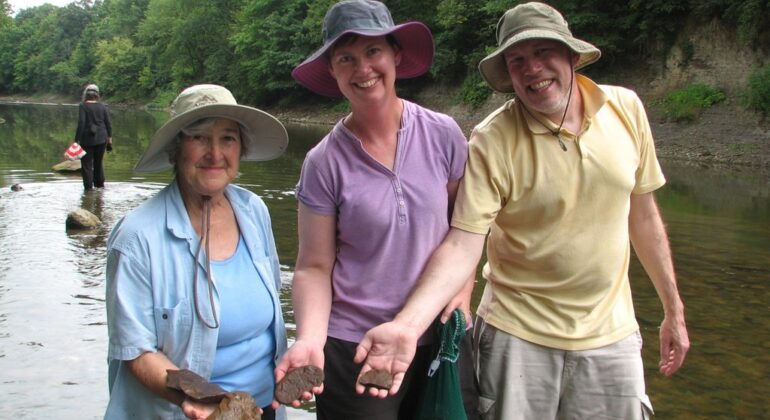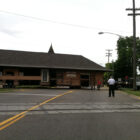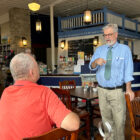by Nancy Uznanski
All of you are on private property at Mazon Creek Fossil Beds – a National Historic Landmark. It is a ten acre world renowned fossil site in the Illinois and Michigan (I&M) Canal National Heritage Corridor.
You know you will be looking for fossils. But you did not know why the site was important. During an introductory talk, you get to touch and feel some fossils that have been found there. As you may have expected, you see beautiful fossilized ferns. You also see organisms that are rare in fossils, like shrimp, worms, millipedes and flying insects.
You are told they were created by an unusual process more than 300 million years ago: before dinosaurs roamed the earth. It may be hard to believe, but you learn that as the plants and creatures died they were rapidly buried by silt that lacked oxygen, according to Andrew Young, the guide giving your introduction. You learn it was similar but not the same as the process by which coal develops, and these deposits are found above coal seams.
The silt that surrounded the organisms turned into relatively small, generally oval rocks called concretions, he said. Then slow decay of the plant or animal wrapped in this silt cocoon allowed for a chemical reaction that preserved not only hard parts, but the soft parts too. That difference in the fossilization process gives scientists an opportunity to see and study some of their internal organs.
After a slow and bumpy hay rack ride, you are at the creek. As Young said might happen, you are lucky enough to see a fossil laying open on the bank. It has nice clean lines because it cracked naturally, along its fossil plain, due to our seasonal freeze-thaw cycles, he said. He also said you would find many more closed concretions than open. You do find some that have not opened. Although you are anxious to know what you have, it is recommended that you wait.
The clean lines from the open fossils, often show whole creatures like the fresh water shrimp you just touched during your introduction. However, opening the closed ones right away, by smacking them with a hammer, can crack right through the fossil, Young said. So to see the surprise inside, you are taught a process that takes patience, but should cause them to open with less chance of damaging their prehistoric content.
The focus of Family Days is on the children and their experience, but parents are privileged to learn right along with them and also find it an exciting and stimulating day, Young said. The day even includes a swim in a pool, weather permitting, and a cook out after all that fresh air and exercise.
An offshoot of another event created in 2011 for serious collectors, Family Days started in 2019 as a one day event. The focus on children is a result of a number of requests including one to bring a nine year old aspiring paleontologist, according to Ana B. Koval, President CEO Canal Corridor Association.
It is only one of many sites in the area where the concretions from this period can be found, including what is called Pit 11, where the Tully Monster, the Illinois State Fossil, was found. The main difference is that fossils here are found on the Earth’s surface along a short section of Mazon Creek, without digging.
At the juncture of privately owned properties, Peter Kodat, on whose farm part of the National Historic Landmark is located, had many regular requests to see it. One came from Dave Dolak an environmental scientist/geologist and instructor at Columbia College, Chicago.
“I met Pete in the early 2000’s when I asked permission to do some collecting and research on the site,” Dolak said. “He allowed me to do surface collecting and observational research. And he entrusted me to not destroy the property, and not to let people dig into the hills, which would damage the integrity of the site.”
“After that, Pete would call me from time to time and ask if I would give a tour for researchers or museum groups. They were well aware of what was there and many of their museums (around the world) had collections, but they wanted to see it firsthand.”
“Then about ten or eleven years ago, Ana, Pete’s wife, asked me if I thought people would pay to collect specimens there, and make it a fundraiser for her organization. I said they certainly would because it’s so famous. So she and Pete and I started it,” Dolak said.
Originally collectors could go one day a year, with Dolak as the technical expert introducing the site and acting as guide. All the help including Ana’s is volunteer, and all the proceeds go to the Canal Corridor Association projects, he said.
The ‘Mazon Creek Fossil Tour Fossil Collectors Day’ quickly became two days, then four with the family days. Andrew Young, a photographer, artist and biologist and his wife, Marie Angkuw, a taxidermist, joined an early tour and soon became part of the crew. Many volunteers help and some even make a meal for the collectors to enjoy at the end of the day when they have a show and tell about what they have found.
Koval concluded that it makes her happy to see others learn about and enjoy the site. Thanks to the generosity of Peter Kodat and now his grandson, Cory Kodat, plus many volunteers it has become a fulfilling addition to the many interesting experiences of the Illinois & Michigan Canal National Heritage Area (IMCNHA).
Nancy Uznanski is a freelance writer.





